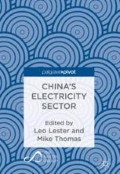Abstract
This chapter shows how key elements of the governance of China’s electrical power sector have evolved over the past twenty years. It will focus on such issues as policy paradigms and priorities, government and industry structures, the distribution of power and influence, the balance between administrative and economic instruments, and the links with trends in the wider economy and other sectors. The key political and economic importance of the power sector has meant that the government remains deeply involved in many aspects of the sector, from enterprise ownership to tariff setting, and has allowed market forces to play only a limited role. The recent round of reforms launched since 2015 marks a further incremental step in enhancing the role of market forces.
Access this chapter
Tax calculation will be finalised at checkout
Purchases are for personal use only
References
Lieberthal K G & Oksenberg M (1988) Policy Making in China. Leaders, Structures and Processes (Princeton: Princeton University Press).
Grunberg N (2016) ‘Revisiting Fragmented Authoritarianism in China’s Central Energy Administration’, in Brodsgaard K E (ed.) Chinese Politics as Fragmented Authoritarianism. Earthquakes, Energy and Environment (Abingdon: Routledge).
Davidson M R, Kahrl F & Karplus V (2016) ‘Towards a Political Economy Framework for Wind Power. Does China Break the Mould?’, Working Paper 2016/32, United Nations University, World Institute for Development Economics Research.
Andrews-Speed P (2012) The Governance of Energy in China: Transition to a Low-Carbon Economy (London: Palgrave Macmillan).
Downs E S (2008) ‘Business Interest Groups in Chinese Politics: The Case of the Oil Companies’ in Li C (ed.) China’s Changing Political Landscape. Prospects for Democracy (Washington, DC: Brookings Institution Press).
Dorian J P (1994) Minerals, Energy and Economic Development in China (Oxford: Clarendon Press).
Pan J, Peng W & Others (2006) ‘Rural Electrification in China, 1950–2004, Program on Energy and Sustainable Development’, Working Paper No. 60, Stanford University.
Yang M & Yu X (1996) ‘China’s Power Management’, Energy Policy, 8, 735–757.
U.S. Energy Information Administration (2012) Annual Energy Review 2012, https://www.eia.gov/totalenergy/data/annual/#electricity, date accessed 6 June 2017.
Xu Y-C (2002) Powering China. Reforming the Electrical Power Sector in China (Aldershot: Ashgate).
Thomson E (2003) The Chinese Coal Industry: An Economic History (London: RoutledgeCurzon).
National Bureau of Statistics (various years) China Statistical Yearbook (Beijing: National Bureau of Statistics).
BP (2016) BP Statistical Review of World Energy (London: BP).
Andrews-Speed P (2004) Energy Policy and Regulation in the People’s Republic of China (London: Kluwer Law International).
Economy E (2004) The River Runs Black. The Environmental Challenge to China’s Future (Ithaca, N.Y.: Cornell University Press).
Delang C O (2016) China’s Air Pollution Problems (Abingdon: Routledge).
Nyman J & Zeng J (2016) ‘Securitization in Chinese Climate and Energy Politics’, WIRES Climate Change, 7, 301–313.
Xu Y-C (2017) Sinews of Power. Politics of the State Grid Corporation of China (Oxford: Oxford University Press).
International Energy Agency (2006) China Power Sector Reforms. Where to Next? (Paris: OECD/IEA).
Yeh E T & Lewis J I (2004) ‘State Power and the Logic of Reform in China’s Electricity Sector’, Pacific Affairs, 77, 437–465.
Andrews-Speed P (2013) ‘Reform Postponed. The Evolution of China’s Electricity Markets’, in Sioshansi F (ed.), Evolution of Global Electricity Markets. New Paradigms, New Challenges, New Approaches (Amsterdam: Elsevier).
Johnson T M (1992) ‘China’s Power Industry, 1980–1990: Price Reform, and Its Effect on Energy Efficiency’, Energy, 17, 1085-1092.
Li B & Dorian J P (1995) ‘Change in China’s Power Sector’, Energy Policy, 23, 619–626.
Lema A & Ruby K (2007) ‘Between Fragmented Authoritarianism and Policy Coordination: Creating a Chinese Market for Wind Energy’, Energy Policy, 35, 3879–3890.
Yuan J, Na C & Yang M (2016) ‘Energy Efficiency and Conservation in China’s Power Sector: Progress and Prospects’, in Su B & Thomson E (eds.) China’s Energy Efficiency and Conservation. Sectoral Analysis (Singapore: Springer).
Myllyvyrta L & Shen X (2016) Burning Money. How China Could Squander over One Trillion Yuan on Unneeded Coal-Fired Capacity (Beijing: Greenpeace).
U.S. Energy Information Administration (2016) Electric Power Annual Report 2016, https://www.eia.gov/electricity/annual/html/epa_08_01.html, date accessed 6 June 2017.
Yuan J, Li P, Wang Y, Liu Q, Shen X, Zhang K & Dong L (2016) ‘Coal Power Overcapacity and Investment Bubble in China During 2015–2020’, Energy Policy, 97, 136–144.
Lewis J I (2013) Green Innovation in China. China’s Wind Power Industry and the Global Transition to a Low-Carbon Economy (New York: Columbia University Press).
Matthews J A & Tan H (2015) China’s Renewable Energy Revolution (Basingstoke: Palgrave Macmillan).
National Development and Reform Commission (2015) Interpretation of Power Sector Reform (Beijing: People’s Publishing House) (in Chinese).
Author information
Authors and Affiliations
Editor information
Editors and Affiliations
Rights and permissions
Copyright information
© 2018 The Author(s)
About this chapter
Cite this chapter
Andrews-Speed, P. (2018). Governance of the Electricity Sector. In: Lester, L., Thomas, M. (eds) China’s Electricity Sector. Palgrave Pivot, Singapore. https://doi.org/10.1007/978-981-10-8192-7_2
Download citation
DOI: https://doi.org/10.1007/978-981-10-8192-7_2
Published:
Publisher Name: Palgrave Pivot, Singapore
Print ISBN: 978-981-10-8191-0
Online ISBN: 978-981-10-8192-7
eBook Packages: Economics and FinanceEconomics and Finance (R0)

